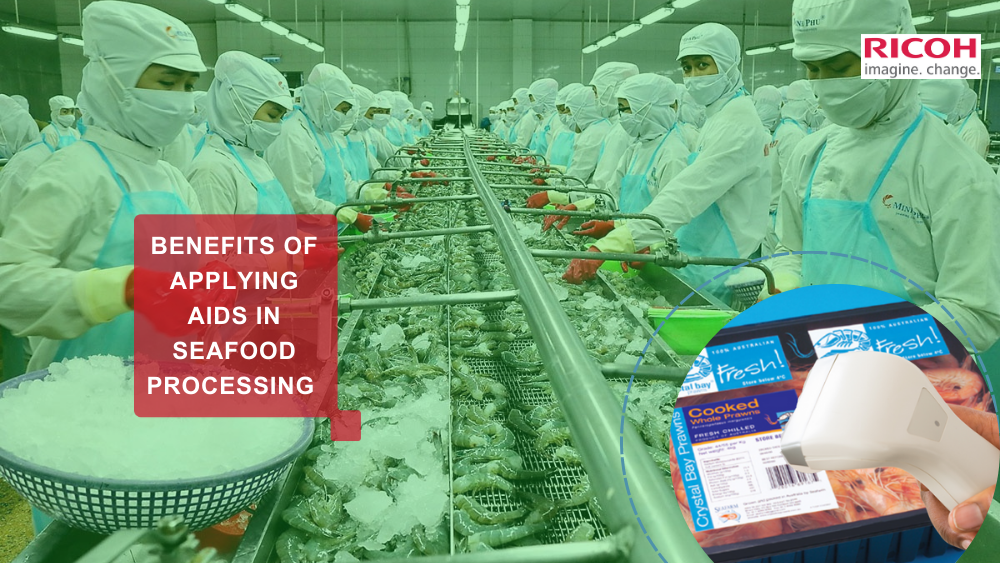Benefits of Applying Automatic Identification (AIDs) Technology in Seafood Processing
As discussed in the previous article, AIDs is a system that combines RFID or barcode technology with data management to automatically identify, collect, and manage product information in the seafood processing workflow.
AIDs ensures transparency, traceability, and food safety throughout the seafood processing process, improving production efficiency, quality management, and consumer trust. Read previous article
In this article, we will explore the significant benefits that AIDs brings when applied in seafood processing.
Optimizing Production Processes
With its automatic recognition and quick information storage capabilities at each stage, the AIDs system fundamentally increases accuracy, eliminating errors from manual tasks and storing structured information for various purposes efficiently, such as:
- Source traceability and automated management
- Optimizing quality inspection processes
- Smart inventory managementEnhancing transparency and consumer trust
- Supporting production planning decisions
Enhancing Traceability and Automatic Management
In the seafood processing industry, source traceability from the beginning to the end, from raw materials to consumers, plays a crucial role. When applying automatic identification systems, each seafood batch and product will be attached with a barcode or RFID tag, providing clear information about the catching location, catching time, fishing vessel, and related processing procedures.
Data is accurately, continuously recorded, and stored through the automatic identification system's information retrieval feature. This way increases accuracy, minimizes errors from manual tasks, and facilitates checking and quality control. Businesses can easily recall affected seafood batches and take timely corrective measures regarding food safety issues.
All countries have labeling information requirements and regulations for source traceability, etc. Usually, to meet these requirements, labels need to contain clear and essential information such as product name, expiration date, ingredients, storage instructions, etc. The material used for printing labels also plays a key role. Moreover, labels must withstand harsh processing, storage, and usage conditions. Choosing high-quality labels enhances the overall efficiency of the AIDs system due to the following reasons:
- Product Identification: In seafood processing, each product will have a unique barcode that a barcode reader can scan. Therefore, thermal labels must produce highly sharp, high-resolution images to display minor, intricate characters. This allows essential information to be printed within the same area, such as processing methods, certifications, contraindications, or additional import information on the secondary label. Optional colored logos can also increase brand recognition.
- Durable Information and Images in Harsh Conditions: Seafood often undergoes processes such as freezing, refrigeration, and thawing under standard conditions or microwave ovens. Continuous exposure to cold, moisture, and wet environments can cause labels to peel or tear, leading to information loss or blurriness. Therefore, selecting water-resistant, durable labels that use adhesive suitable for cold storage is essential.

In Vietnam, Ricoh's thermal labels are widely trusted and used across various industries due to their ability to meet these requirements. Contact Ricoh IMS Vietnam for advice on the most suitable thermal labels for your business needs.
Ensuring Product Quality and Safety
AIDs allow monitoring of storage conditions such as temperature, humidity, expiration dates, and other vital parameters during processing and transportation. Tight control of these factors helps maintain product quality and food safety, avoiding potential business risks.
The structured data collection and storage also facilitate post-audit and pre-audit quality checks, which are more convenient than traditional bookkeeping or manual data entry methods.
Enhancing Warehouse Management Efficiency
AIDs enables automatic and accurate warehouse management, saving time and warehouse management costs. The system automatically identifies and tracks inventory levels, making accurate and timely decisions regarding stock-in, stock-out, and reordering.
One of the crucial features ensured when implementing AIDs in warehouse operations is:
- Item location identification: This helps save time retrieving and ensures the correct item is picked.
- Supporting First-In-First-Out (FIFO) method implementation: Minimizing waste due to strict food safety requirements.

Boosting Customer Trust
Applying AIDs in seafood processing allows businesses to ensure transparency and product quality. Customers can easily access information about the origin, production process, and other related factors through barcodes printed on the labels or packaging of the product. This enhances customer trust and satisfaction with the product.
Businesses need to play a two-way role in providing clear and accurate barcodes on labels, avoiding cases of smudged or illegible barcodes or torn labels. Learn more about specialized label types for the seafood industry on the Ricoh Vietnam website.
Conclusion
Applying Automatic Identification (AIDs) technology in seafood processing brings various significant benefits, including enhanced traceability, optimized production processes, ensured product quality and safety, improved warehouse management efficiency, and increased customer trust. Businesses in the industry should consider AIDs a valuable tool to elevate production quality and competitiveness in the market.
Related articles
News & Events
Keep up to date
- 13Mar
Ricoh named in “Clarivate Top 100 Global Innovators 2025” list
- 06Mar
Ricoh ranked 39th in Carbon Clean200™ 2025 list
- 17Feb
Ricoh selected as a member of the Sustainability Yearbook 2025 by S&P Global
- 14Feb
Ricoh recognized with double ‘A’ score for climate action and water security leadership in CDP A List for two consecutive years
